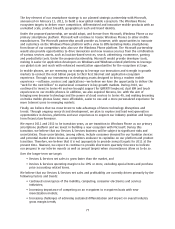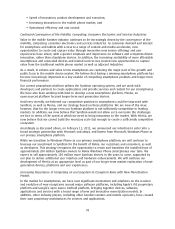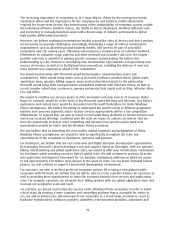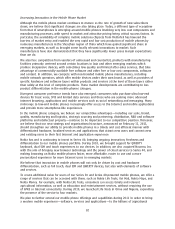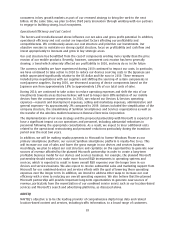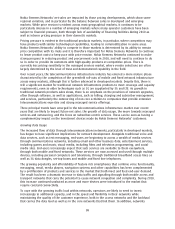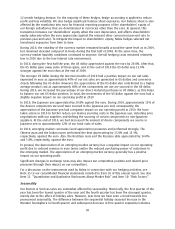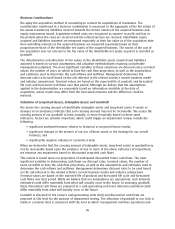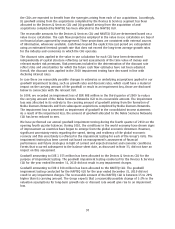Nokia 2010 Annual Report Download - page 88
Download and view the complete annual report
Please find page 88 of the 2010 Nokia annual report below. You can navigate through the pages in the report by either clicking on the pages listed below, or by using the keyword search tool below to find specific information within the annual report.require optimization to meet the signalling challenge they face from applications that are “always
on”. That investment is likely at first to come in upgrades to existing 3G, core and backhaul networks
and later in the move towards LTE, and it will require both hardware and software investment.
Nokia Siemens Networks has intensified and focused its investment in research and development in
its network systems business and in the radio access area, in order to offer the products and software
that respond to the growing requirement of operators for efficient networks that can “smartly”
handle the data growth at reasonable cost. During 2010, Nokia Siemens Networks launched its
“Golden Cluster” program, designed to combine all of its assets and expertise into a single solution to
optimize networks for smart devices. By focusing on the relevant technologies, such as flat
architectures, capacity scaling, fat pipes, proper radio coverage, and radio network features that
increase smart device battery life and reduce signalling, Nokia Siemens Networks believes that it is
well positioned to serve its customers’ current and future needs.
Managed Services and Outsourcing
A second trend has been the acceleration in the development of the managed services market as
operators are increasingly looking to outsource network management to infrastructure vendors. The
primary driver for this trend is that managed services providers are able to offer economies of scale in
network management that allow the vendor to manage such contracts profitably while operators can
reduce the cost of network management. The outsourcing trend is also underpinned by many operators
taking the view that network management is no longer either a core competence or requirement of
their business and are increasingly confident that they can find greater expertise by outsourcing this
activity to a trusted partner that can also improve quality and reliability in the network.
Nokia Siemens Networks believes that this trend will continue and that it could in future be driven by
financial imperatives of its customers. While data traffic has grown at very high rates over recent
years, fuelling the requirement for capital expenditure in networks, many operators have yet to see a
corresponding growth in revenues from users, a dynamic that has the potential to threaten their
profitability levels. As capital expenditure increases, some operators are looking to other areas to
sustain and grow profitability, and in particular many operators are looking to control their operating
expenditure. In those circumstances, the outsourcing of the management of their network to
infrastructure vendors such as Nokia Siemens Networks can be an attractive option.
In emerging markets, such as Africa and India, price pressure and competition in the enduser market
has increased the financial pressure on many operators, and that in turn has resulted in a similar
trend as operators have looked to control and cut costs through outsourcing network management.
The trend towards network management outsourcing is evident in every region of the world and has
intensified during 2010. Nokia Siemens Networks has contracts in all regions and in 2010 was
awarded contracts in new markets such as Africa, Russia, Australia and Latin America. Nokia Siemens
Networks believes that such a trend generates its own momentum in the market as vendors can
increasingly demonstrate their capabilities with reference accounts and operators are exposed to their
competitors taking steps that can enhance profitability and improve network quality and reliability.
Nokia Siemens Networks, which employs approximately 45 000 services professionals, continues to
build its managed services capability to address the growing demand for outsourcing. For example, it
manages nearly half a billion subscribers and has managed services contracts with 158 operators
around the world. Nokia Siemens Networks has developed a global delivery model that offers the
benefits of scale and efficiencies both to Nokia Siemens Networks and its customers. The model is
based on the delivery of services from three global network solutions centres in Lisbon, Portugal and
Chennai and Noida in India, the latter of which was opened in 2009. During 2010, Nokia Siemens
Networks announced that it will open new global networks operations centers in both Russia and
Brazil to support the move towards managed services in those regions. These new global operations
centers are expected to open in the first half of 2011. Increasingly, Nokia Siemens Networks is
addressing opportunities in multivendor network management, where the customer network might
87


